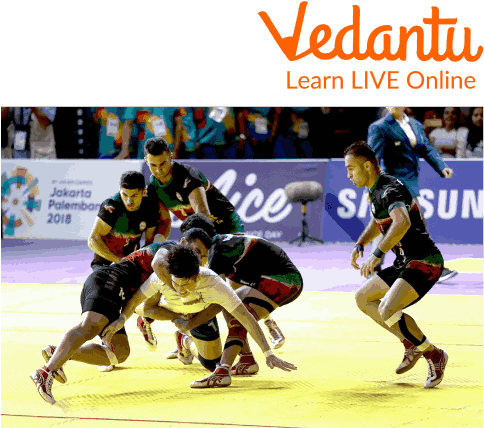




Let’s Learn More About Kabaddi
4,000 years ago, India created the team sport known as Kabaddi, which is now popular throughout South Asia. The word for "holding of hands," which is the key element of play, comes from a Tamil word. It mixes the elements of rugby and wrestling and is a team sport that calls for both strength and finesse. Originally, it was intended to help people learn how to defend themselves as well as how to react to an attack and counterattack both individually and collectively. It is a relatively easy and cheap game that doesn't call for a huge playing area or pricey equipment. Now, let’s dive in and learn more about kabaddi for kids.
Kabaddi Information for Kids
A physical team sport, kabaddi is. The goal of the game, which is played between two teams of seven players, is for a single offensive player, known as a "raider," to run into the other team's half of the court, touch out as many of their defenders as they can, and then return to their half of the court without being tackled by the defenders and all in the space of one breath. The opposing team scores a point for halting the raider, and points are awarded for each player the raider tags. Players are removed from the game if they are touched or tackled, but they are allowed to reenter for each goal their team scores due to a tag or tackle.

Kabaddi
History of Kabaddi
The game has been played in a lot of ways since prehistoric times. Since 1930, the modern Kabaddi game has been played in India and certain other regions of South Asia. In Maharashtra in the year 1921, for Kabaddi competitions on the combined pattern of Sanjeevani and Gemini, the earliest framework of the game's regulations is believed to have been created. After that, a committee established in 1923 revised all the norms created in 1921. The All India Kabaddi Tournament, held in 1923, used these revised regulations.
The All India Kabaddi Federation was established in 1950 to handle the game's promotion, and the Senior National Championship debuted in 1952. The new organisation, the Amateur Kabaddi Federation of India (AKFI), 1972 was founded and is associated with the Indian Olympic Association (IOA). Its goal is to spread awareness of the sport throughout India and its Asian neighbours. Kabaddi completely changed after this organisation was created, and competitions for junior and under-junior boys and girls at the national level also began.
How to Play Kabaddi?
Kabaddi is one of the most popular Indian games. It is almost a common game among young and old people in India. This game comprises 16 players, divided into two teams - raiders and defenders. The norm for playing Kabaddi matches is as follows:
Two teams arrange themselves on two long sides of the field with a small width in front of these two sides (10 metres). There are six members in each team, three raiders and three defenders. The raider captures the ball from behind their sideline within 1 minute by running close to it without being called out at any point.
International Competitions
There are many international Kabaddi competitions held every year at national and international levels. Some of them are given as follows.

International kabaddi Competitions for Children
Kabaddi World Cup
Men's and women's national teams compete in the Kabaddi World Cup, an outdoor international kabaddi sport run by the International Kabaddi Federation (IKF).
Asian Games
Before it became a medal event for the first time in 1990, kabaddi in 1951, 1982, and again in 1990 was played as a demonstration sport in the First Asian Games.
Pro Kabaddi League
In 2014, the Pro Kabaddi League was founded. With a strong emphasis on marketing, the support of local broadcaster Star Sports, and adjustments to the sport's regulations and presentation to make it fitter for a television audience, the league structured its operation after the Indian Premier League of Twenty20 cricket.
Indo International Premier Kabaddi League
On May 13 in Pune, India, the IIPKL held its first competition. The Bangalore Rhinos won and took home the championship for the first season.
Super Kabaddi League
To rekindle interest in the sport in Pakistan, the Super Kabaddi League was first played there in May 2018.
Asian Kabaddi Championship
India earned their tenth gold medal after defeating Pakistan in the finals of the AKC's tenth season, held in Gorgan, Iran, in 2017.
Kabaddi Masters
The first Kabaddi Masters was held in Dubai from June 22 to June 30, 2018. It was the country's first-ever kabaddi competition. India won the match by defeating Iran 44–26 in the championship game, with the Indian defence outplaying Iran's security.

Children Playing Kabaddi Outdoors
Summary
From this article, Kabaddi for kids, we have learnt some valuable information about Kabaddi and How to play Kabaddi. By tackling players of the opposite squad, you can score points. The raider then makes an effort to get back to their half. Throughout the entire raid, they hold their breath and chant the word "Kabaddi." If the raider touches any of their opponents, they may cross the lobby. They will be "out" if they don't touch anyone. The All India Kabaddi Federation was established in 1950 to handle the game's promotion, and the Senior National Championship debuted in 1952.
FAQs on Kabaddi Information for Kids: Understanding the Traditional Sport
1. Who is the most well-known kabaddi player?
Narwal, Pardeep. He is currently one of India's top Kabaddi players in terms of popularity.
2. Which nation is the kabaddi king?
India has won all seven World Cups, all seven Asian Games, both Asian Indoor Games, and each of the seven Asian Games for men.
3. Does Kabaddi exist in America?
Yes. The national kabaddi team of the United States made its international debut at the 2016 Kabaddi World Cup in Ahmedabad, India.









